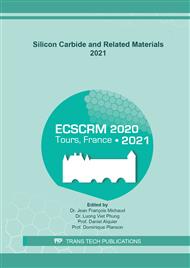p.528
p.533
p.539
p.544
p.549
p.554
p.560
p.565
p.570
SiC Diode with Vertical Superjunction Realized Using Channeled Implant and Multi-Step Epitaxial Growth
Abstract:
This work details two approaches with multi-epitaxial growth to create a vertical superjunction structure made of alternating pillars. One approach is a chain of very high energy implants, the other uses a preferred implantation direction to achieve a channeled profile. The manufactured devices show a breakdown voltage of 1000 V for channeled, two-step epi with total 4.9 μm thickness. 800 V for regular high energy implants using three epi steps of total 3.7 μm thickness. The measured Rsp was 0.7 mOhm*cm2 for dies with size 0.018 cm2. UIS and temperature measurement show reliable performance. The channeled implant looks favorable to reduce the number of process steps needed to create an efficient superjunction structure.
Info:
Periodical:
Pages:
549-553
Citation:
Online since:
May 2022
Keywords:
Permissions:
Share:
Citation:


